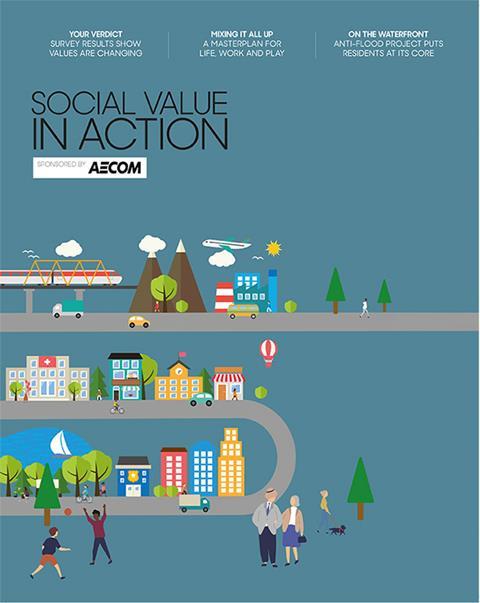To minimise the harms of coronavirus and to rebuild better, we need stimulus-funded infrastructure that seeks to maximise social value, says Aecom’s Mary Zsamboky
The coronavirus outbreak has brought severe social and economic consequences, with the economy expected to endure its deepest recession in decades. People on low incomes are among the hardest hit, in terms of both the health toll and economic impact.
The government has responded with a £30bn support package. Alongside this, £640bn is to be invested in infrastructure over the next five years, providing jobs and longer-term opportunities. The National Infrastructure Strategy, once published, will provide further details on what is claimed to be the biggest programme of public investment ever.
To make the most of this vital funding for transport, schools, hospitals, homes and more, investment should seek to maximise public or “social” value. This means including non-financial considerations such as community wellbeing and environmental sustainability in the business case, and prioritising projects that achieve positive wider outcomes for the public.
Political priority
Social value has risen up the political and industry agenda since parliament passed the Public Services (Social Value) Act in 2012. To maximise the impact of public expenditure, public bodies are required to consider whether they can secure added economic, social or environmental benefits for their local area when procuring goods and services. Since March 2019, the government has proposed a minimum weighting of 10% on social value in contracts being procured by public bodies. This highlights a commitment to maximise social value through public sector procurement, which accounts for about a third of all public expenditure.
Creating opportunities
Infrastructure investments provide many opportunities to deliver social value to the communities and regions. Major projects can represent once-in-a-lifetime regeneration investments, with opportunities to enhance the employment prospects of disadvantaged or marginalised members of society who might otherwise be excluded from the labour market. In rural areas, access to infrastructure can provide a lifeline to key services.
A social value approach can help the most vulnerable, who now face the biggest challenges
For infrastructure investment to provide maximum returns for society requires a holistic, long‑term approach that responds to the economic, social and environmental needs of society. Wider non-financial considerations and externalities (positive and negative) are hard to measure, but they give decision-makers a fuller understanding of the risks and benefits of projects. Applying a social value lens helps people to think more strategically across the project lifecycle to consider how infrastructure should be planned, designed, constructed, operated and decommissioned.
A good way to start is to map social value outcomes against the UN’s Sustainable Development Goals (SDGs). Organisations can identify which outcomes materially contribute to the achievement of relevant SDGs and assess where there may be other sustainable development issues that could influence value creation.
Different kinds of capital
Aecom has developed an ”integrated capitals approach” that allows organisations to make better-informed decisions to deliver multiple, lasting benefits to communities that go beyond narrow economic considerations. This involves taking into account the many forms of capital that enrich society: not just financial but also the built and natural environments, intellectual and other human potential, and the strength of social bonds and civil institutions. The approach facilitates a deeper understanding of the trade-offs made in decision-making and can help organisations identify where to shift resources to create more overall value.
Benefits to society
Integrating social value into cost-benefit analysis calculations enables decision-makers to balance the need to achieve return on investment with a commitment to generating benefits to society, while minimising environmental damage. It allows commissioners to set out tangible objectives in project proposals and encourages greater engagement with suppliers, service users and other key stakeholders.
A social value approach can also help the most vulnerable, who now face the biggest challenges. Putting social value at the centre of decision-making means stimulus spending on infrastructure can be leveraged to provide employment, raise living standards, improve social wellbeing and strengthen community resilience. This will be essential if we hope to achieve economic growth and social equity in a post-coronavirus era.
Mary Zsamboky is an associate director in Aecom’s policy and appraisal team































No comments yet